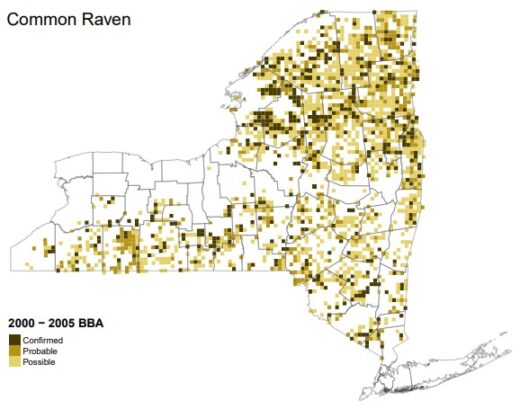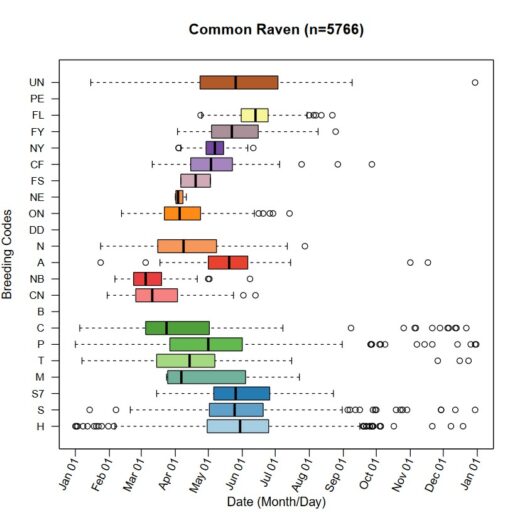Common Ravens are among the largest members of the crow family and the largest passerines in the world. Their expansive and unique repertoire of vocalizations make them easy to recognize and entertaining to observe. As is true of most corvids, Common Ravens are highly capable problem solvers, which has allowed them to expand their range and population size adjacent to expanding human populations.
Top Tips
- Common Ravens begin nesting in late January to mid-April, so keep an eye out for birds carrying sticks, nesting materials, or hanging around nests from previous years.
- Keep an eye out for recently fledged young as early as April and May as they can become less and less distinguishable as recently fledged by late summer. They can also be highly mobile once flighted, and not reliably counted as fledged within a given block.
- While simply carrying food isn’t evidence enough to confirm breeding in Common Ravens, they are often carrying food items large enough to see and can indicate the direction to head in search of a nest, young, and the opportunity to observe breeding behaviors.
Where to Find Them
Common Ravens can be found nearly anywhere in New York although they are less common in densely populated areas. While they are less common in dense urban areas, Common Ravens are already confirmed breeding in many urban blocks, so you should never count them out as simply a visitor if encountered there. In these areas, ravens will nest on man made structures like building ledges, water towers, power line towers, windmills, and cell towers.
In forested and wilderness areas Common Ravens will utilize coniferous and broad leaved trees for nesting where their raptor-like stick nests can be seen near the top of a tree, though usually with some canopy cover. Common Ravens are also notorious for nesting on cliff sides under overhangs.
Common Ravens can favor a wide array of habitats and will capably breed wherever there may be high enough structure to build a nest. They are found in open grasslands and agricultural fields adjacent to forest patches or even cell and water towers. In forested areas, Common Ravens utilize a wide range of deciduous and coniferous cover. They often can be found at the intersection of forests and varying other habitat types, usually making use of natural nesting areas including cliffs. In New York and the northeast, Common Ravens typically leave highways and busy roadsides for American and Fish Crows.

Distribution of Common Raven from the 2000-2005 Atlas.
When to Find Them
Common Ravens are non-migratory year round residents in New York. They are early nesters, so it is worthwhile to note areas of Common Raven activity in winter to follow up on later in the breeding season. Common Ravens can start building or repairing nests as early as late January, finishing within days or weeks depending on their level of building and repairs. Females lay eggs soon after the nest is complete, and they will begin incubating after completing their clutch. As they are early to build nests and lay eggs, nestlings and fledglings can be seen and heard as early as April through May and June. Keep in mind that fledgling ravens can become mobile quite rapidly, so be cautious to restrict calling birds recently fledged to the less mobile and non-flighted stages. Fledged Common Ravens can be fed by parents well into becoming juveniles when they are nearly as mobile as their parents.
Breeding Calendar
- January to March: Courtship, pair formation, nest building, egg laying
- March to May: Nest building, egg laying, and incubation, fledglings
- May-Jul: Fledglings, feeding young
- July-Oct: Feeding young
How To Find Them
Common Ravens are often easy to hear on an atlasing outing, but they can be secretive around their nest while it contains eggs and nestlings. Common Ravens are a species that can require some patience and repeated visits to hone in on breeding behaviors within a block since they are capable of traversing wide distances to acquire food and nesting resources.
As there is no single appropriate habitat for Common Ravens, listen for their calls and multitude of vocalizations throughout the morning and evening, although they can be heard regularly throughout the day. Smaller birds mobbing ravens can be an indicator to follow a raven as they often rob nests for food for themselves and their young. Keep in mind that ravens are a species where just being seen carrying food may not be sufficient to code them as carrying food. They will carry away food for themselves to eat without disturbance, especially when being mobbed after robbing another bird or their nest.
Behaviors To Look For
Although Common Ravens are often highly vocal, they are adept at spotting potential predators and ceasing vocalization quickly. As their repertoire is expansive and varies regionally, there is little evidence supporting specific vocalizations related to breeding.
- Singing. Although Common Ravens do not have a set song, the vocalizations given by males and females can be attributed as S (Singing).
- Pairs. Code P (pair) should be used with caution throughout the breeding season. Two birds calling at or near each other may not be a pair, and could be territorial rivals.
- Nest building. Common Ravens will carry sticks, mosses, and strip bark from trees to use in their nests. Even when reusing a nest they will often add more sticks and lining materials so NB (nest building) can be used when witnessing these behaviors.
- Feeding young. Adults feed their young a variety of food sources, and when out of the nest they can also be fed whole food items. Any feeding of young out of the nest can be coded FY (feeding young).
- Occupied nest. Since nests are typically high and it can be difficult to determine the contents, when an adult is seen sitting on a nest use ON.
- Nest with young. Chicks visible in the nest receive the code NY (nest with young).
- Recently fledged. Common Raven coloring can make it difficult to determine when a chick has reached the ability to fly and become more mobile. When young are still fluffy and appear to be unable to fly reliably you can safely use FL (recently fledged).
Life History
Common Ravens are a globally exceptional bird species in many regards. Common Ravens are among the largest of songbirds, closely tied with other raven species found elsewhere across the globe. They also have one of the most expansive ranges of any bird in the world. Raven species are also considered some of the greatest problem solvers of all birds, and even among all animals by some measures. This problem solving has led them to be successful in a wide variety of habitats in the northern hemisphere, and often considered troublemakers and pests in many instances.
Common Ravens are not only habitat generalists, but they are willing scavengers, hunters, and food generalists as well. Ravens will scavenge through garbage and animal carcasses, formerly being known for following American Bison and wolves as a means of scavenging on the remains of wolf prey. Common Ravens are themselves capable hunters that will fly fields to catch rodents, pull chicks and eggs from nests, or steal food from other avian predators. Common Ravens will eat insects, birds, mammals, reptiles, and fish while also scavenging through human garbage for food items. They are known to raid tern and gull colonies, sometimes as a team, to the point of wiping out smaller colonies over a season.
As pests, they are known to interfere with human agriculture from crops to livestock including chicks, small fowl, and even pecking at the eyes and afterbirth of newborn sheep and goats. Additionally, their inquisitive nature leads them to pull cables, peel labels, and damage other human products in a variety of ways.
Common Ravens are non-migratory and a mated pair will maintain and defend their territory year round. Very little is known about dispersal of young after leaving the care of their parents, but banded juveniles have been spotted as far as 500km away from their banding site. As mated pairs retain their same territory all year, they will sometimes reuse nests from prior years, typically with some repairs. They will also build new nests throughout their territory if a nest is damaged beyond repair, or it is deemed unsuitable for other reasons that are unclear to humans.
The size of Common Raven territories varies based on habitat and resource availability. In areas of high food and resource abundance territories can be as small as 5 square kilometers, but they can expand to more than 40 square kilometers where resources are scarce. Common Ravens will defend their nesting areas from other ravens, crows, hawks, owls, and falcons should they attempt to prey on eggs or nestlings.




